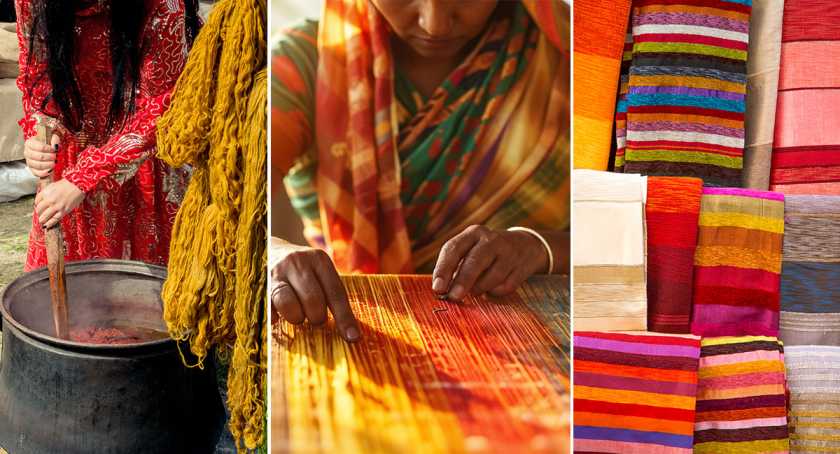The Use of Vegetable Dyes in Odisha’s Textile Industry
Odisha, a state in eastern India, is noted for its cultural legacy and vibrant textile industry. Among the many factors contributing to the uniqueness of Odisha’s textiles, the use of vegetable dyes stands out as a significant tradition. These natural dyes, extracted from plants, roots, leaves, and flowers, add aesthetic appeal to fabrics and ensure sustainability and eco-friendliness. This blog examines the historical context of vegetable dyes, their use in Odisha’s handloom fabrics, and their environmental and industry effects.
Historical Context
The tradition of using vegetable dyes in Odisha’s textiles dates back several centuries. The indigenous weavers of the state, particularly from regions like Sambalpur, Bargarh, and Cuttack, have mastered the art of natural dyeing. The famous Ikat (Bandha), Bomkai, and Kotpad textiles extensively use vegetable dyes, reflecting the deep-rooted heritage of Odisha’s handloom sector.
Religious beliefs and rituals initially influenced the application of vegetable dyes in Odisha’s textiles. The weavers considered using natural elements as a divine practice aligned with their cultural traditions. Over time, the process evolved, integrating more sophisticated techniques while preserving the traditional essence of handloom weaving.
Sources Used in Odisha Handlooms
Odisha’s diverse flora offers a wealth of sources for vegetable dyes. Some of the commonly used natural dyeing agents include:
- Madder Root (Rubia cordifolia) – Used to obtain deep red and maroon shades.
- Indigo (Indigofera tinctoria) – Produces vibrant shades of blue.
- Turmeric (Curcuma longa) – Gives bright yellow hues.
- Pomegranate Peel (Punica granatum) – Used for yellow and green shades.
- Tamarind Seed Powder – Provides grey and brown tones.
- Haritaki (Terminalia chebula) – Used for soft black shades.
- Myrobalan (Emblica officinalis) – Enhances the vibrancy of other colors and acts as a mordant.
- Catechu (Acacia catechu) – Produces brown and earthy tones.
- Sappanwood (Caesalpinia sappan) – Used for pink and purple shades.
Artisans extract these dyes by boiling, fermenting, or soaking natural materials. Mordants such as alum, iron, and lime juice fix the fabric’s dyes and enhance their longevity.
The Process of Using Vegetable Dyes
Vegetable dyeing involves a careful, labor-intensive process that ensures vibrant and long-lasting colors.
The steps typically include:
- Selection of Natural Ingredients: Different plant-based sources are chosen based on the required color.
- Extraction of the Dye: The selected plant material is soaked, boiled, or fermented to extract the color pigment. The process varies depending on the plant source and the depth of shade required.
- Preparation of Fabric: To fix the dye, the fabric is washed thoroughly to remove impurities and then treated with a mordant like alum, iron, or myrobalan.
- Dyeing Process: The fabric is submerged in the dye solution several times to achieve the desired shade. Artisans then let the linen dry in the sun to set the color.
- Finishing Touches: The dyed fabric undergoes additional treatments to enhance its colorfastness and durability. It is finally washed and dried before being woven into intricate textile designs.
Incorporating Vegetable Dyes into the Textile Industry
- Enhancing Cultural and Artistic Identity: It is deeply intertwined with Odisha’s artistic traditions, shaping the state’s textiles. The region’s distinctive weaves, such as Sambalpuri Ikat and Kotpad, uniquely appeal to the natural dyeing techniques employed by skilled artisans. The color patterns and motifs often depict mythological themes, nature, and folk traditions, preserving Odisha’s cultural identity.
- Promoting Eco-Friendly and Sustainable Practices: They are biodegradable and non-toxic, making them an environmentally sustainable alternative to synthetic dyes. Unlike chemical dyes, which contribute to water pollution and pose health hazards to weavers, vegetable dyes ensure minimal environmental impact. By promoting natural dyeing, Odisha’s handloom industry is vital in fostering sustainable fashion.
- Supporting Rural Economy and Livelihoods: Handloom weaving and vegetable dyeing provide employment opportunities to thousands of artisans in Odisha. The dyeing process involves multiple stages, from sourcing raw materials to dye extraction and fabric processing, thus creating livelihood opportunities for rural communities. Furthermore, the increasing global demand for organic textiles has opened new markets for Odisha’s naturally dyed handloom products.
- Enhancing Textile Durability and Comfort: Natural dyes produce exquisite colors and improve fabric quality. Textiles dyed with vegetable colors are breathable, skin-friendly, and durable. The absence of synthetic chemicals makes them ideal for people with sensitive skin, adding to their popularity in contemporary fashion markets.
- Preserving Traditional Knowledge and Skills: Artisans in Odisha’s weaving communities have passed down vegetable dyeing techniques through generations. By continuing to use these traditional techniques, artisans preserve their ancestral knowledge and ensure that the heritage of handloom textiles remains intact. Government initiatives and organizations supporting the revival of handlooms have helped keep this craft alive.
The Future of Vegetable Dyes in Odisha’s Textile Industry
Naturally, colored textiles are gaining popularity due to the rise of ethical and sustainable fashion. Designers, eco-conscious brands, and fashion houses are collaborating with artisans in Odisha to revive and promote vegetable dyeing techniques. Initiatives such as organic textile certification and fair-trade practices can further support this industry.
Government support in terms of funding, training programs, and international marketing opportunities will be crucial in sustaining this traditional craft. Additionally, awareness campaigns highlighting the environmental and health benefits of vegetable-dyed fabrics can encourage more consumers to make conscious choices.
Final Thoughts
Vegetable dyeing is not just a coloring technique but a testament to Odisha’s rich textile legacy and sustainable craftsmanship. Nature’s vibrant hues continue to breathe life into Odisha’s handloom industry, preserving tradition and the environment. By supporting naturally dyed textiles, we can contribute to a greener future while keeping the heritage of Odisha’s artisans alive for generations to come.


